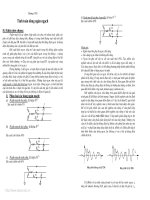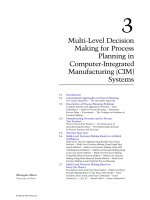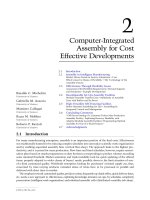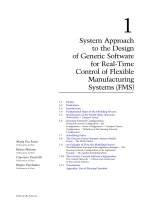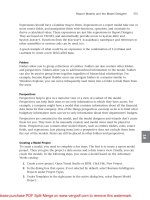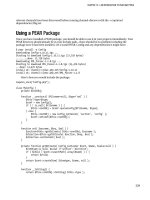Tài liệu Computer-Aided.Design.Engineering.and.Manufacturing P8 pptx
Bạn đang xem bản rút gọn của tài liệu. Xem và tải ngay bản đầy đủ của tài liệu tại đây (286.82 KB, 22 trang )
Chang, Shing I "A Hybrid Neural Fuzzy System for Statistical Process Control"
Computational Intelligence in Manufacturing Handbook
Edited by Jun Wang et al
Boca Raton: CRC Press LLC,2001
©2001 CRC Press LLC
18
A Hybrid Neural Fuzzy
System for Statistical
Process Control
18.1 Statistical Process Control
18.2 Neural Network Control Charts
18.3 A Hybrid Neural Fuzzy Control Chart
18.4 Design, Operations, and Guidelines
for Using the Proposed Hybrid Neural
Fuzzy Control Chart
18.5 Properties of the Proposed Hybrid Neural
Fuzzy Control Chart
18.6 Final Remarks
Abstract
A hybrid neural fuzzy system is proposed to monitor both process mean and variance shifts simulta-
neously. One of the major components of the proposed system is composed of several feedforward neural
networks that are trained off-line via simulation data. Fuzzy sets are also used to provide decision-making
capability on uncertain neural network output. The hybrid control chart provides an alternative to
traditional statistical process control (SPC) methods. In addition, it is superior in that (1) it outperforms
other SPC charts in most situations in terms of faster detection and more accurate diagnosis, and (2) it
can be used in automatic production processes with minimal human intervention — a feature the other
methods ignore. In this chapter, theoretical base, operations, user guidelines, chart properties, and
examples are provided to assist those who seek an automatic SPC strategy.
18.1 Statistical Process Control
Statistical process control (SPC) is one of the most often applied quality improvement tools in today’s
manufacturing as well as service industries. Instead of inspecting end products or services, SPC focuses
on processes that produce products and services. The philosophy of a successful SPC application is to
identify sources of special causes of production variation as soon as possible during production rather
than wait until the very end. Here “production” is defined as either a manufacturing or service activity.
SPC provides savings over traditional inspection operations on end products or service because it
eliminates accumulations of special causes of variation by monitoring key quality characteristics during
production. Imagine how much waste is generated when a production mistake enters a stream of products
during mid-day but inspection doesn’t take place until the end of an 8-hour shift. SPC can alleviate this
situation by frequently monitoring the production process via product quality characteristics.
Shing I Chang
Kansas State University
©2001 CRC Press LLC
A quality characteristic (QC) is a measure of quality on a product or service. Examples of QC are
weight of a juice can, length of a cylinder part, the number of errors made during payroll operations,
etc. A QC can be mathematically defined as a random variable, which is a function that takes values from
a population or distribution. Denote a QC as random variable
x
. If a population
Ω
only contains discrete
members, that is,
Ω
= {x
1
, x
2
, …, x
n
}, then QC
x
is a discrete random variable. For example, if
x
is the
number of errors made during payroll operations, then member x
1
is the value in January, x
2
is the value
in February, and so on. In this case, attribute control charts can be used to monitor a QC with discrete
distribution. A control chart for fraction nonconforming, also known as a P chart, based on binomial
distribution, is the most frequently used chart (Montgomery, 1996). However, in this chapter, we will
focus only on a more interesting class of control charts when QC
x
is a continuous random variable
where
x
can take a value in a continuous range, i.e.,
x
∈
Ω
={
x
| L
≤
x
≤
U}. For example,
x
is the weight
of a juice can with a target weight of 8 oz.
The central limit theorem (CLT) implies that the sample mean of a continuous random variable
x
is
approximately normally distributed where the sample mean is calculated by
n
independently sampled
observations of
x
. The approximation improves when the size of
n
increases. In much of the quality
control literature,
n
is chosen to be 5 to 10 when the approximation is considered good enough. Note
that CLT does not impose any restriction on the original distribution on
x
, which provides the foundation
for control charts. Since the sample mean of
x
,
–
x
, is approximately normal distributed, i.e.,
N
(
µ
,
σ
2
/
n
)
where
µ
and
σ
are the mean and standard deviation of
x
, respectively, we can collect
n
observations of
a QC, calculate its sample mean, and plot it against a control chart with three lines. If both
µ
and
σ
are
known, the centerline is
µ
with lower control limit and upper control limit . If CLT
holds and the process defined by QC
x
remains in control, 99.73% of the sample population will fall
within the two control limits. On the other hand, if either
µ
or
σ
shifts from its target, this will increase
the probability that sample points plot outside the control limits, which indicates an out-of-control
condition.
A pair of control charts are often used simultaneously to monitor QC
x
— one for the mean
µ
and
the other for the standard deviation
σ
. The goal is to make sure the process characterized by QC
x
is
under statistical control. In other words, SPC charts are used to verify that the distribution of
x
remains
the same over time. Since a probability distribution is usually estimated by two major parameters,
µ
and
σ
, SPC charts monitor the distribution through these two parameters. Figure 18.1 (Montgomery, 1996)
demonstrates two out-of-control scenarios. At time
t
1
, the mean
µ
0
of
x
starts to shift to
µ
1
. One of the
most often used control charts, chart, can be used to detect this situation. On the other hand, at
time
t
2
, the mean is on target but the standard deviation has increased from
σ
0
to
σ
1
where
σ
1
>
σ
0
. In
this case, a control chart for ranges (R chart) can be used to detect the variation change. Notice that SPC
charts are designed to detect assignable causes of variation as indicated by mean or standard deviation
shifts and at the same time tolerate the chance variation as shown by the bell-shaped distribution of
x
.
Such a chance variation is inevitable in any production process.
Statistical process control charts have been applied to a wide range of manufacturing and service
industries since Shewhart first introduced the concept in the 1920s. There have been several improvements
on the traditional control charts since then. Page (1954) first introduced cumulative sum (CUSUM)
control charts to enhance the sensitivities of detecting small process shifts. Instead of depending solely
on data collected in the most recent sample period for plotting in the traditional Shewhart-type control
chart, the CUSUM chart’s plotting statistic involves all data points previously collected and assigns an
equal weight factor for every point. If a small shift occurs, CUSUM statistic can accumulate such a
deviation in a short period of time and thus increase the sensitivity of an SPC chart. However, CUSUM
charts cannot be plotted as easily as the Shewhart-type control charts. Roberts (1959) proposes an
exponential weighted moving average (EWMA) control chart that weighs the most recent observations
more heavily than remote data points. EWMA charts were developed to have the structure of the
traditional Shewhart charts, yet match the CUSUM charts’ capability of detecting small process shifts.
µ
σ
– 3
n
µ
σ
+3
n
X
©2001 CRC Press LLC
Most control chart improvements over the years have been focused on detecting process mean shifts,
with a few exceptions that are discussed in the following section.
Shewhart R, S, and S
2
charts are the first statistical control charts for monitoring process variance
changes. Johnson and Leone (1962a, 1962b) and Page (1963) later proposed CUSUM charts based on
sample variance and sample range. As an alternative, Crowder and Hamilton (1992) developed an expo-
nential weighted moving average (EWMA) scheme based on the log transformation of the sample variance
ln
(S
2
). Their experimental results show that the EWMA chart outperforms the Shewhart S
2
chart and is
comparable to the CUSUM chart for variation proposed by Page (1963). Using the concept of log
transformation of sample variance, Chang and Gan (1995) suggest a CUSUM scheme based on
ln
(S
2
),
which performs as well as the corresponding EWMA. Performances of Chang and Gan’s (1995) CUSUM
and Crowder and Hamilton’s (1992) EWMA are not significantly better than Page’s (1963) CUSUM;
however, their development of design strategies and procedures are relatively easier for practitioners to use.
18.2 Neural Network Control Charts
In recent years, attempts to apply neural networks to process control have been investigated by several
researchers. Guo and Dooley (1992) proposed network models that identify positive mean or variance
changes using backpropagation training. Their best network performs 40% better on the average error
rate than conventional control chart heuristic tests.
Pugh (1989, 1991) also successfully trained backpropagation networks for detecting process mean
shifts with subgrouping size of five. He found his networks equal in average run length (ARL) performance
to a 2-
σ
control chart in both type I and II errors.
Hwarng and Hubele (1991, 1993) trained a backpropagation pattern recognition classifier to detect
six unnatural control chart patterns — trend, cycle, stratification, systematic, mixture, and sudden shift.
Their results were promising in recognizing various special causes in out-of-control situations.
Smith (1994) and Smith and Yazici (1993) described a combined X-bar and R chart backpropagation
model to investigate both mean and variance shifts. They found their networks performed 50% better
in average error rate when compared to Shewhart control charts. However, the majority of the wrong
FIGURE 18.1
In-control and out-of-control scenarios in SPC. (From Montgomery, D.C., 1996,
Introduction to
Statistical Quality Control
, 2nd ed. p. 131. Reproduced with the permission of John Wiley & Sons, Inc.)
Assignable cause three
is present; process is
out-of-control
Assignable cause two
is present; process is
out-of-control
Assignable cause one
is present; process is
out-of-control
Only chance causes of
variation present;
process is in
control
LSL
Process quality characteristic, x
Time, t
USL
µ
0
µ
1
>
µ
0
σ
0
σ
0
σ
0
µ
2
<
µ
0
σ
1
>
σ
0
σ
1
>
σ
0
t
1
t
2
t
3
©2001 CRC Press LLC
classification is of type I error. That is, the network signals too many out-of-control false alarms when
the process is actually in control.
Chang and Aw (1994) proposed a four-layer backpropagation network and a fuzzy inferencing system
for detecting process mean shifts. Their network outperforms conventional Shewhart control charts in
terms of both type I and type II errors, while Pugh’s and Smith’s charts have larger type I errors than
that of the 3
σ
chart. Further, Chang and Aw’s scheme has the advantage of identifying the magnitude
of shifts. None of the Shewhart-type charts, or the other neural network charts, offer this feature. Chang
and Ho (1999) further introduced a two-stage neural network approach for detecting and classifying
process variance shifts. The performance of the proposed method is comparable to that of the other
control charts for detecting variance changes as well as being capable of estimating the magnitude of the
variance change, which is not supported by the other control charts. Furthermore, Ho and Chang (1999)
integrated both neural network control chart schemes and compared this with many other approaches
for monitoring process mean and variance shifts. In this chapter, we will summarize the proposed hybrid
neural fuzzy system for monitoring both process mean and variance shifts, provide guidelines and
examples for using this system, and list the properties.
18.3 A Hybrid Neural Fuzzy Control Chart
As shown in Figure 18.2 (Ho and Chang, 1999), the proposed hybrid neural fuzzy control chart, called
C-NN (C stands for “combined” and NN means “neural network”), is composed of several modules —
data input, data processing, decision making, and data summary. The data input module takes observa-
tions from QC
x
and transforms them into appropriate types for both control charts for mean M-NN
and for variance V-NN, which are the major components of the data processing module. The decision-
making module is responsible for interpreting the neural network outputs from the previous module.
There are four distinct possibilities: no process shift, process mean shift only, process variance shift only,
and both process mean and variance shifts. Note that two different classifiers — fuzzy and neural network
— are adopted for the process mean and variance components, respectively. Finally, the data summary
module calculates estimated shift magnitudes according to appropriate diagnosis. Details of each module
will be discussed in the following sections.
18.3.1 Data Input Module
The data input module takes samples or observations of QC
x
in two ways. Sample observations,
x
1
,
x
2
, …, and
x
n
in the first input method are independent of each other. In the proposed system,
n
is chosen
as five, that is, each plotting point consists of a sample of five observations. Traditional Shewhart-type
control charts normally use this input method.
A moving window of five observations is used for the second method to select incoming observations.
For example, the first sample point consists of observations
x
1
,
x
2
, . . . ,
x
5
and the second sample point
is composed of
x
2
,
x
3
, . . . ,
x
6
, and so on. This method is explored due to the fact that both CUSUM
and EWMA charts for mean shifts are capable of taking individual observations. The proposed moving
range method comes close to individual observation in terms of the number of observations used for
decision making. Unlike the “true” individual observation input method, the moving range method must
wait until the fifth observation to complete the first sample point to start using the proposed chart. After
this point, it is on pace with the “true” individual observation input method in that it uses the most
recent and four immediately passed observations. The reason for maintaining a few observations in a
sample point is due to the need to evaluate process variation. An individual observation does not provide
such information.
Transformation is also a key component in the data input module. As we will discuss later, both neural
networks were trained “off-line” from simulated observations. In order to make the proposed schemes work
for various applications, data transformation is necessary to standardize the raw data into the value range
that both neural network components can work with. Formulas for data transformation are as follows:
X
©2001 CRC Press LLC
18.3.1.1 Transformation for M-NN Input
Equation (18.1)
where
i
is the index of observations in a sample or window;
t
is the index for the sample period, and
and
s
are estimates of process mean and standard deviation, respectively. In traditional control charts, it
takes 100 to 125 observations, e.g., 25 samples of 4 or 5 observations each, to establish the control limits.
However, in this case, 20 to 30 observations can provide reasonably good estimates.
18.3.1.2 Transformation for V-NN Input
Given the data standardization in Equation 18.1, the input for V-NN of variance detection needs to
further process as
Equation (18.2)
where
t
and
i
are the same as those defined in Equation 18.1, and is the average of five transformed
observations
z
ti
of the sample at time
t
.
18.3.2 Data Processing Module
The heart and soul of the proposed system is a module composed of two independently developed neural
networks: M-NN and V-NN. M-NN, developed by Chang and Aw (1996), is a 5–8–5–1 four-layer neural
network for detecting process mean shift. On the other hand, Chang and Ho’s (1999) V-NN is a 5–12–12–1
neural network for detecting process variance shift. Data from transformation formulas (Equations 18.1
and 18.2) are fed into M-NN and V-NN, respectively. Both neural networks have single output nodes.
M-NN’s output values range from –1 to +1. A value that falls into a negative range indicates a decrease in
process mean value, while a positive M-NN output value indicates a potential increase in process mean
shift. On the other hand, V-NN’s output ranges from 0 to 1 with larger values meaning larger shifts. Note
that both neural networks were trained off-line using simulations. By incorporating the trained weight
matrices, one can start using the proposed method. The only setup required is to estimate both process
mean and variance for transformation. The central limit theorem guarantees that transformed data is
FIGURE 18.2
A schematic diagram of C-NN (combined neural network) control chart. (Adapted from Ho and
Chang, 1999, Figure 3, p. 1891.)
Sample Observations
Individual Observations
Trans-
formation
M-NN
V-NN
Cutoff
value(s)
Cutoff
value(s)
Mean/
Variance
Shift
Mean
Shift
Fuzzy
Classifier
Neural
Classifier
Shift
Magnitude
Shift
Magnitude
Variance
Shift
z
xx
s
i
ti
ti
==…
–
,,,,,123 5
x
IzzI
ti ti t
==…–, ,,,12 5
z
t
©2001 CRC Press LLC
similar to the simulated data used for training. Thus the proposed method can be applied to many
applications with various data types as long as they can be defined as QC
x
. Before M-NN and V-NN
are introduced in detail, we first summarize calculation and training of any feedforward, multiple-layer
neural networks as follows.
18.3.2.1 Computing in a Neural Network
The most commonly implemented neural network is the multilayer backpropagation network, which
adapts weights according to the steepest gradient descent rule along a nonlinear transformation function.
The reason for this popularity is due to the versatility of its paradigm in solving diverse problems, and
its strong mathematical foundation. An example of a multilayer neural network is shown in Figure 18.3.
In neural networks, information propagates from input nodes (or neurons) through the system’s weight
connections in the middle layers (or hidden layers) of nodes, finally passing out the last layer of nodes
— the output nodes.
Each node, for example node
j
in the hidden and output layers, contains the input links with weights
w
ij
, an activation function (or transfer function)
f
, and output links to other nodes as shown in Figure
18.4. Assuming
k
input links are connected to node
j
, the output
V
j
of node
j
is processed by the activation
function
Equation (18.3)
where
V
pi
is the output of node
i
from the previous layer.
Many activation functions, e.g., sigmoidal and hyperbolic-tangent functions, are available. We choose
to use the sigmoidal function
Equation (18.4)
where
c
is a coefficient that adjusts the abruptness of the function.
FIGURE 18.3
An example of a multilayer neural network.
Input Layer
Hidden Layers
Output Layer
VfI
IwV
jj
jijpi
i
k
=
()
=
=
∑
,
,
1
fI
e
cI
()
=
+
1
1
–
©2001 CRC Press LLC
18.3.2.2 Training of a Neural Network
Backpropagation training is the most popular supervised neural network training algorithm. The training
is designed to modify the thresholds and weights so that the overall error will be minimized. At each
iteration, we first calculate error signals
δ
o
, o = 1, 2, . . . ,
n
o
, for the output layer nodes as follows:
Equation (18.5)
where
f' (I)
is the first-order derivative of the activation function f(I); t
o
is the desired target value; and
V
o
is the actual output for output node o. We then update the weights connected between hidden layer
nodes and output layer nodes:
w
ho
(new) = w
ho
(old) +
ηδ
o
V
h
+ α[∆w
ho
(old)], Equation (18.6)
where
η
is a constant chosen by users for adjusting training rate;
α
is a momentum factor;
δ
o
is obtained
from Equation 18.5; V
h
is the output of node h in the last hidden layer; and ∆w
ho
is the previous weight
change between node h and output node o. Subsequent steps include computing the error signals for a
hidden layer(s) and propagating the errors backward toward the input layer. The error signals for node
h in the current hidden layer are
Equation (18.7)
where V
h
is the output for node h in the current hidden layer under consideration; w
ih
is the weight
coefficient between node h in the current hidden layer and node i in the next hidden layer; δ′
i
is the error
signal for node i in the next hidden layer; and n′ is the number of nodes in the next hidden layer. Given
the error signals from Equation 18.7, the weight coefficient w
jh
between node j in the lower hidden layer
and node h in the current hidden layer can be updated as follows:
w
jh
(new) = w
jh
(old) +
ηδ
h
V
j
+ α[∆w
jh
(old)], Equation (18.8)
FIGURE 18.4 Node j and its input–output values in a multilayer neural network.
V
p1
V
V
Node j at Current
Layer
Nodes in the Next
Layer
W
1j
Transfer
Function
f
W
2j
W
ij
W
kj
V
p2
V
pi
V
pk
i
i
δ
o o o ooo
fI tfI V V tV=
() ()
()
=+
()()()
'– . ––,05 1 1
δδ δ
hhih
i
n
i
hhih
i
n
i
fI w V V w=
′
()
′
=+
()()
′
=
′
=
′
∑∑
11
051 1.± ,

